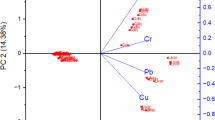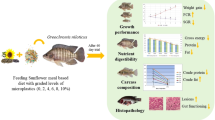Abstract
Farmed fish are exposed to risks from feed-borne chemical contamination, such as leucomalachite green (LMG) in fish meal. Consequently, the use of malachite green is prohibited in aquacultural practice. An improved understanding of the toxicity of dietary LMG provided to farmed fish is needed in order to manage risk. Oreochromis niloticus specimens were fed experimental diets containing 0, 100, 500, and 2500 μg/kg LMG for 28 days. On sampling days 7, 14, and 28, fish in the exposed groups had detectable levels of LMG. Accumulation levels were approximately 12.2 % (in the liver) and 6.2 % (in the muscle) of the LMG concentration in the feed (104, 510, and 2200 μg/kg). Hematocrit and mean corpuscular hemoglobin concentrations in the 500 and 2500 μg/kg groups were significantly elevated at 7 and 14 days. Hemoglobin in the group that received the highest dose was significantly higher than that in the control group. Significant increases in the activities of alanine aminotransferase and alkaline phosphatase were also detected in the group receiving the highest dose. Total cholesterol concentrations in all of the exposed groups were significantly higher than those in the control group. These observations of toxicity were dose dependent. Histological changes in gills and livers were observed in LMG-exposed fish.



Similar content being viewed by others
References
FAO/WHO (2009) Evaluation of certain veterinary drug residues in food: seventieth report of the Joint FAO/WHO Expert Committee on Food Additives (WHO Technical Report Series, no. 954). WHO, Geneva
Takagi M, Yamatani S, Sugiura K (2011) Guidelines used in Japan to prevent the contamination of feed products with undesirable substances. Vet Ital 47:49–52
Hardy RW, Lee CS (2010) Aquaculture feed and seafood quality. Bull Fish Res Agen 31:43–50
Andersen WC, Roybal JE, Turnipseed SB (2004) Determination of malachite green and leucomalachite green in salmon with in situ oxidation and liquid chromatography with visible detection food and drug administration (FDA/ORA/DFS Laboratory Information Bulletin no. 4334). FDA, Denver
Srivastava S, Sinha R, Roya D (2004) Toxicological effects of malachite green. Aquat Toxicol 66:319–329
Dacie JV, Lewis SM (1963) Practical hematology. J & A Churchill, London
Yang MC, Fang JM, Kuo TF, Wang DM, Huang YL, Liu LY, Chen PH, Chang TH (2007) Production of antibodies for selective detection of malachite green and the related triphenylmethane dyes in fish and fishpond water. J Agric Food Chem 55:8851–8856
Andersen WC, Turnipseed SB, Roybal JE (2005) Quantitative and confirmatory analyses of malachite green and leucomalachite green residues in fish and shrimp (FDA/ORA/DFS Laboratory Information Bulletin no. 4363). FDA, Denver
Jiang Y, Xie P, Liang G (2009) Distribution and depuration of the potentially carcinogenic malachite green in tissues of three freshwater farmed Chinese fish with different food habits. Aquaculture 288:1–6
Henderson AL, Schmitt TC, Heinze TM, Cerniglia CE (1997) Reduction of malachite green to leucomalachite green by intestinal bacteria. Appl Environ Microbiol 63:4099–4101
Omoregie E, Ofojekwu PC, Anosike JC, Adeleye AO (1998) Acute toxicity of malachite green to the Nile tilapia, Oreochromis niloticus (L.). J Aquat Trop 13:33–237
Srivastava AK, Sinha R, Singh ND, Roy D, Srivastava SJ (1995) Malachite green induced changes in carbohydrate metabolism and blood chloride levels in the freshwater catfish, Heteropneustes fossilis. Acta Hydrobiol 37:113–119
Yildiz HY, Pulatsu S (1999) Evaluation of the secondary stress response in healthy Nile tilapia (Oreochromis niloticus L.) after treatment with a mixture of formaline, malachite green and methylene blue. Aquac Res 30:379–383
Petri D, Glover CN, Ylving S, Kolås K, Fremmersvik G, Waagbø R, Berntssen MH (2006) Sensitivity of Atlantic salmon (Salmo salar) to dietary endosulfan as assessed by hematology, blood biochemistry and growth parameters. Aquat Toxicol 80:207–216
Houston AH (1997) Are the classical hematological variables acceptable indicators of fish health? Trans Am Fish Soc 126:879–894
Shaw BJ, Handy RD (2006) Dietary copper exposure and recovery in Nile tilapia, Oreochromis niloticus. Aquat Toxicol 76:111–121
Wepener W, Van Vuren JHJ, Du Preez HH (1992) Effect of manganese and iron at neutral pH values on the hematology of the banded tilapia (Tilapia sparrmanii). Bull Environ Contam Toxicol 49:613–619
Pilgaard L, Malte H, Jensen FB (1994) Physiological effects and tissue accumulation of copper in freshwater rainbow trout (Oncorhynchus mykiss) under normoxic and hypoxic conditions. Aquat Toxicol 29:197–212
Figueiredo-Fernandes A, Ferreira-Cardoso JV, Garcia-Santos S, Monteiro SM, Carrola J, Matos P, Fontaínhas-Fernandes A (2007) Histopathological changes in liver and gill epithelium of Nile tilapia, Oreochromis niloticus, exposed to waterborne copper. Pesq Vet Bras 27:103–109
Abdel-Warith AA, Younis EM, Al-Asgah NA, Wahbi OM (2011) Effect of zinc toxicity on liver histology of Nile tilapia, Oreochromis niloticus. Sci Res Essays 6:3760–3769
Ozer J, Ratner M, Shaw M, Bailey W, Schomaker S (2008) The current state of serum biomarkers of hepatotoxicity. Toxicology 245:194–205
Hoffman WE, Solter SF (2008) Diagnosis enzymology of domestic animals. In: Kaneko JJ et al (eds) Clinical biochemistry of domestic animals, 6th edn. Academic, San Diego, pp 351–378
Srivastava SJ, Singh ND, Srivastava AK, Sinha R (1995) Acute toxicity of malachite green and its effects on certain blood parameters of a catfish Heteropneustes fissilis. Aquat Toxicol 31:241–247
Acknowledgments
This research was supported by JST/JICA, SATREPS.
Author information
Authors and Affiliations
Corresponding author
Rights and permissions
About this article
Cite this article
Seel-audom, M., Krongpong, L., Futami, K. et al. Toxicity and absorption of dietary leucomalachite green in Nile tilapia Oreochromis niloticus . Fish Sci 79, 119–127 (2013). https://doi.org/10.1007/s12562-012-0575-4
Received:
Accepted:
Published:
Issue Date:
DOI: https://doi.org/10.1007/s12562-012-0575-4




